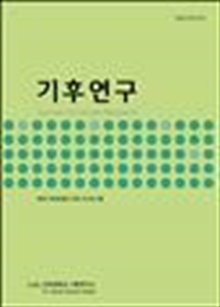간행물
기후연구 KCI 등재 Journal of Climate Research

- 발행기관 건국대학교 기후연구소
- 자료유형 학술지
- 간기 계간
- ISSN 1975-6151 (Print)2288-8772 (Online)
- 수록기간 2006 ~ 2021
- 주제분류 사회과학 > 지리학 사회과학 분류의 다른 간행물
- 십진분류KDC 453DDC 551
권호리스트/논문검색
제10권 제3호 (2015년 9월) 4건
1.
2015.09
서비스 종료(열람 제한)
This study aimed at examining the changes of time series and spatial pattern s of tourism climatic conditions using Korea Tourism Climate Index (KTCI) of South Korea. Spatial patterns of KTCI represent climate characteristics in all seasons of South Korea,. KTCI also shows which tourism climate condition inappropriately (appropriately) shows the changes of tourism activity in the summer (winter) season in response to the global warming. KTCI is therefore expected to be a more suitable index than TCI (Tourism Climate Index) when it comes to the incorporation of the global warming into the index. KTCI can also be used for improving the future prediction about tourism climate conditions and provide useful information for the establishment of countermeasure strategies for climate change.
2.
2015.09
서비스 종료(열람 제한)
This study is analysed on corelation between topographical conditions around 36 weather stations and climate data in South Korea. As a result of analysis, the altitude above sea level shows linear negative corelation with temperature. The low relative height sites appear that sunshine duration and temperature are the lowest and precipitation and precipitation duration are bigger than average by influences of surrounding landform. The relief amount shows high positive corelation with precipitation phenomena such as precipitation, precipitation duration and cloud amount. In terms of the aspect, southern slope sites show the highest daily minimum temperature and sunshine duration, and western slope sites show daily mean and maximum temperatures. The eastern close sites appear the lowest temperature and the highest humidity. The distance from coastline shows linear negative corelation with temperature data. The far distance sites from coastline appear that temperature, precipitation and precipitation duration are the lowest. In respect of landform structures, the piedmont areas show the highest moisture related indicators. The hill areas show the lowest humidity and cloud amount and the longest sunshine duration. Temperature and wind speed are low in basin areas.
3.
2015.09
서비스 종료(열람 제한)
Traffic accidents on the expressways during the high speed driving are severe and more damaging, compared with other traffic accidents. There has been much effort to reduce the traffic accidents by seeking for the cause of the accidents. Apart from drunk driving and driving while drowsy caused by personal carelessness, one of the main causes of the accidents on the expressways is the limit to the straight-ahead. The straight-ahead is much affected by climate and topography. Existing research on this subject investigates the accidents during the driving on the expressways under bad weather, the accidents on the freeways with design problems regarding the topology and grade and the accident frequency varying with traffic volume. The current study suggests a model including precipitation and traffic volume at a time and aims at examining their impacts on the traffic accidents on the expressways by using a binomial logistic regression analysis. The data used were the traffic accident frequency per day over a year on each link of two expressways, Donghae and Yeongdong, which represent Yeongdong and Yeongseo regions of Gangwon Province. The results tell that precipitation and traffic volume significantly affect the occurrence of the traffic accidents. The accident occurrence is also significantly different between the two expressways and even more significantly different between links within each expressway. Further research topics were identified, including the distinction between rainfall and snowfall, the inclusion of mediating variables such as the limit to the straight-ahead due to the precipitation and the differentiation between the degrees of fatality of the traffic accidents.
4.
2015.09
서비스 종료(열람 제한)
This study has calculated the change of wind speed according to the features of land surface roughness using the surface wind data provided by the Korean peninsula data of HadGEM3-RA and has analyzed the characteristics of the future upper wind over South Korea driven by several climate change scenarios. The simulation found that the more the time passes, the more the wind speed increases in the previous time period of upper wind and annual average wind speed time series analysis of three kinds of Representative Concentration Pathways (RCP). The wind speed of all three kinds of RCP increased in the summer and winter but decreased in the spring and fall in the analysis of seasonal time series and spatial distribution. The wind speed would be expected to increase in most months except April and November in the analysis of the monthly mean maximum wind speed. The histogram analysis shows the mean wind speed of upper wind over 3m/s. As the time passes, the wind speed increases more than in the past. Certain areas such as the areas under the urbanization development would be anticipated to raise the wind speed throughout all months.

